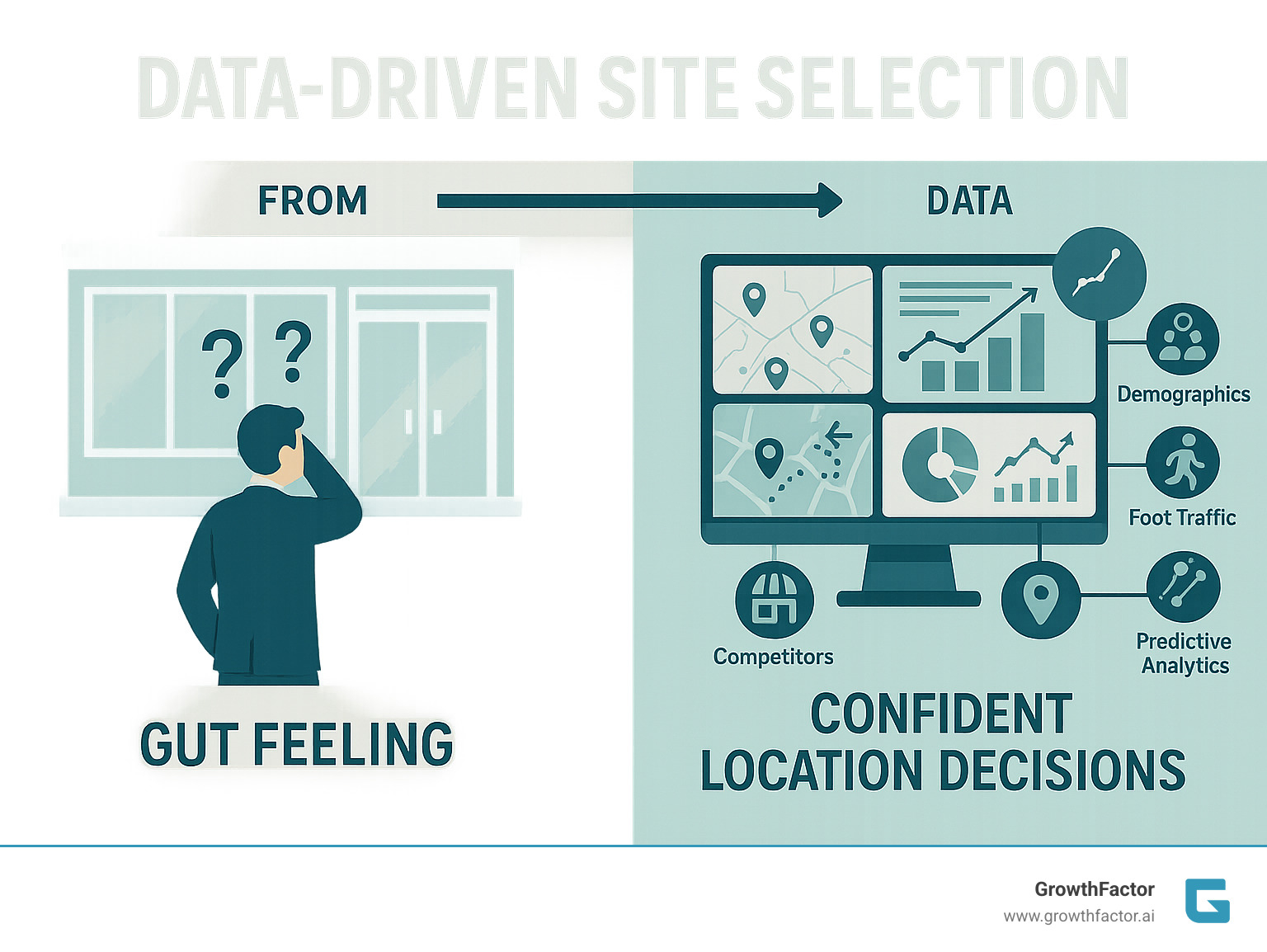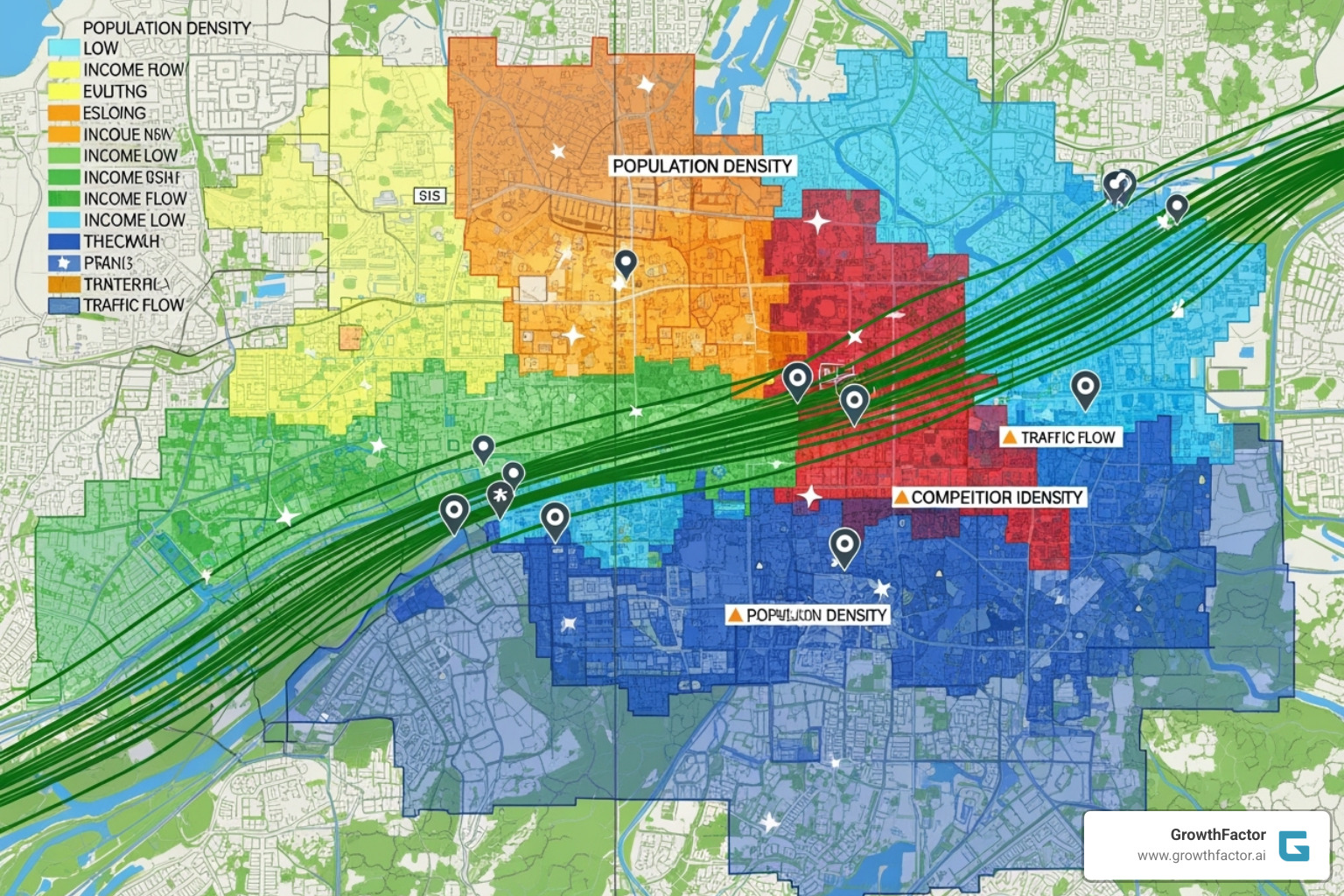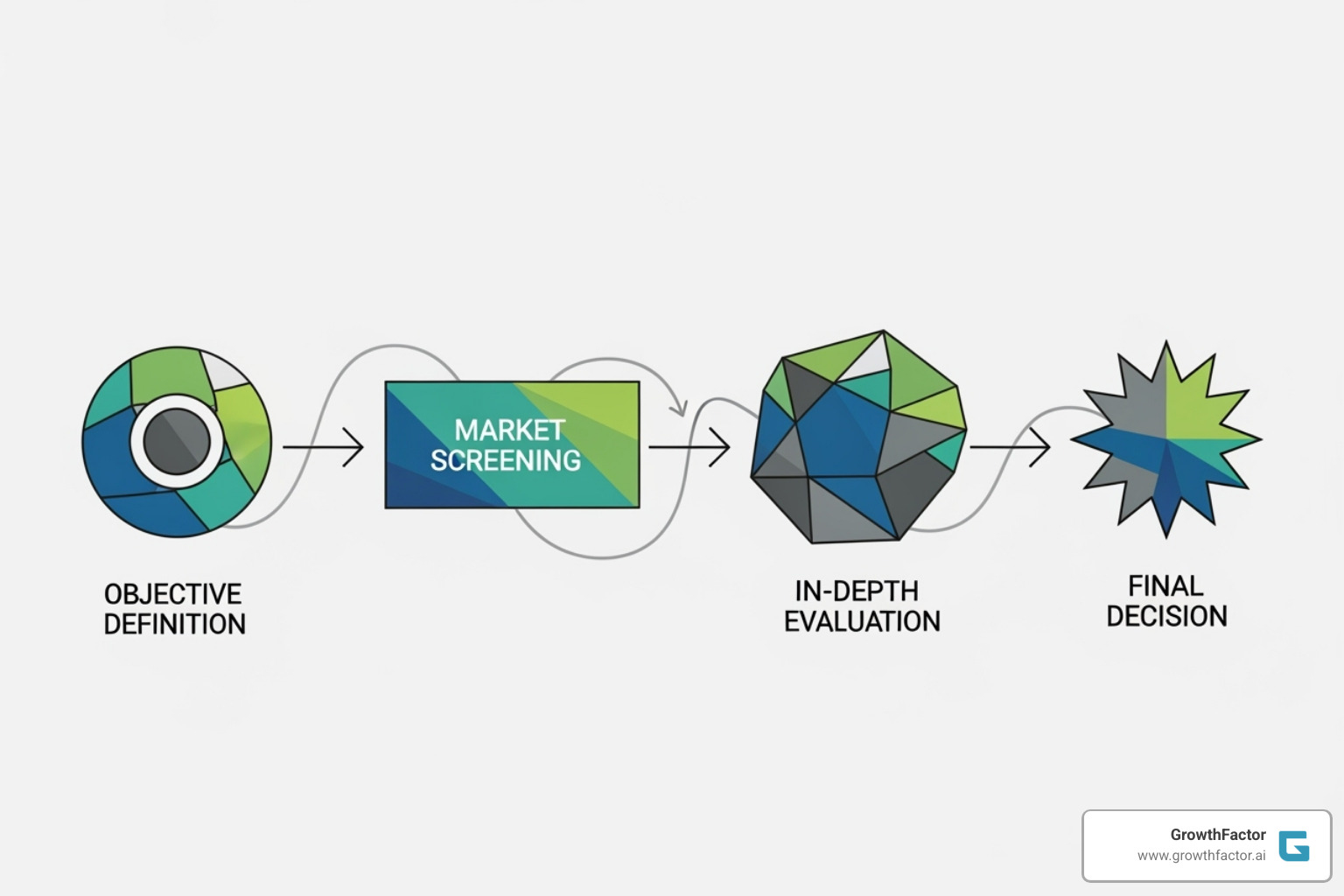Beyond Gut Feelings: A Guide to Data-Driven Site Selection
Why Traditional Site Selection Methods Are Failing Modern Retailers

Data driven site selection transforms location decisions from guesswork into strategic choices backed by objective insights. Instead of relying on gut feelings, modern retailers use comprehensive data analysis to confidently identify optimal locations.
Key Components of Data-Driven Site Selection:
- Demographics & Psychographics - Understanding who lives and works near potential sites
- Mobility & Foot Traffic Data - Tracking real customer movement patterns
- Transaction Data - Analyzing actual spending behaviors in specific areas
- Competitor Analysis - Mapping competitive landscapes and market gaps
- Predictive Modeling - Using AI to forecast sales potential before signing leases
With new locations costing up to $1 million+ and 30% of restaurants failing in their first year, traditional methods are no longer sufficient. The most successful retailers use predictive models to achieve 40% shorter payback periods.
AI-powered platforms evaluate hundreds of locations simultaneously, enabling businesses to evaluate five times more sites with greater accuracy. These systems help break the growth ceiling many chains hit, turning real estate into strategic assets.
I'm Clyde Christian Anderson, Founder and CEO of GrowthFactor.ai. After experiencing the frustrations of spreadsheet-based site selection, my mission is to make sophisticated data driven site selection accessible to all growing retailers.

The "Why": Unpacking the Benefits of Data-Driven Decisions
Data-driven site selection is the difference between guesswork and strategic precision. Traditional methods, like relying on gut feelings, are outdated and risky. This shift to strategic decision-making impacts your entire business.
Increased profitability is central. Understanding an area's demographics, spending habits, and mobility patterns allows you to position your business for maximum profitability. Retailers using sophisticated analytical models achieve 40% shorter payback periods.
Strategic growth means replacing random expansion with systematic planning. Identify underserved markets and optimal locations to scale with confidence, ensuring each new site strengthens your portfolio.
Competitive advantage comes from making informed decisions while others guess. Analyzing mobility trends and customer behavior helps you uncover hidden opportunities and avoid common mistakes.
Risk mitigation is your safety net in a high-stakes industry. With new locations costing up to $1 million and a high failure rate for new businesses, data-driven analysis helps you quantify risks like low foot traffic or high competition before signing a lease, protecting your investment.
Operational efficiency extends beyond the initial choice. Understanding local activity patterns helps fine-tune staffing and inventory, ensuring sustained performance.
Site selection based on objective data like foot traffic, demographics, and competition transforms real estate from a liability into a strategic asset, enabling confident, sustainable growth.
The "What": Key Data Types Fueling Modern Site Selection
When investing hundreds of thousands in a new location, data-driven site selection provides a clear advantage. It involves layering multiple data sources to create a complete picture of a location's potential.

Geographic Information Systems (GIS) and location intelligence platforms turn raw numbers into visual insights, revealing hidden relationships between factors that determine success. Combining geospatial data with these tools provides a competitive advantage by visualizing complex data patterns, eliminating the need for cumbersome spreadsheets.
For a deeper dive into the technical aspects, explore Site Selection Data.
Foundational Data Layers
These layers paint a picture of who lives, works, and shops in any given area.
Demographics answer the "who": population size, age, income, and family status. Matching your business to the local demographic is crucial.
Psychographics reveal the "why" behind consumer behavior, including lifestyle preferences and values. This data can be more predictive of brand affinity than basic demographics.
Points of Interest (POI) mapping of nearby businesses, landmarks, and transport hubs helps identify customer flows, complementary businesses, and market gaps.
Co-tenancy analysis focuses on neighboring businesses, as they significantly impact success. A popular neighbor can boost foot traffic and create synergistic customer flows.
For practical applications, see our guide on Retail Location Analysis.
Dynamic Behavioral Data
This data reveals how people actually move, shop, and spend in real time.
Mobility data from anonymized mobile devices reveals how many people pass a location, when they visit, and their travel patterns, providing precise counts of potential customers.
Foot traffic analysis identifies peak hours and seasonal trends to inform staffing and lease negotiations, validating a location's visitor volume with concrete numbers.
Transaction data reveals actual spending patterns in specific categories, helping forecast sales potential and avoid areas with low demand for your product.
Consumer spending patterns provide broader economic context, helping predict a location's long-term viability by assessing the community's financial health.
True trade area analysis uses mobility data to define a location's actual trade area by showing where visitors come from, offering a precise understanding of your market reach.
Essential Site-Specific Data
Finally, zoom in on the details that can make or break a location.
Zoning regulations are local rules that dictate business type, building restrictions, and parking. Overlooking them can derail a project.
Transportation infrastructure is key to accessibility. Consider highway access, public transit, and parking. Isochrone maps can visualize travel times to the site.
Labor force availability requires analyzing the local talent pool, skills, and wages to forecast labor costs and ensure you can staff your location.
Real estate costs go beyond rent. Account for all costs, including taxes, utilities, and maintenance, to accurately model profitability.
Economic incentives like tax breaks or grants from local governments can significantly improve your return on investment.
The power of data driven site selection comes from layering these data types. Combining demographics, mobility, transaction, and site-specific data provides a comprehensive view that transforms location decisions from gambles into strategic investments.
The "How": Leveraging AI and Predictive Analytics for Optimal Data-Driven Site Selection
Once data is gathered, Artificial Intelligence (AI) and predictive analytics turn it into actionable insights, changing data driven site selection into a streamlined science.

Predictive models analyze historical data to forecast a new location's sales potential before you sign a lease. They are key for sales forecasting, whitespace analysis (identifying untapped markets), and assessing cannibalization risk (ensuring a new store adds customers, not just shifts them).
AI platforms allow teams to evaluate five times more sites and reduce selection time by 80%. This speed is a crucial advantage in competitive markets.
To learn more about AI's transformative impact on real estate, visit AI for Real Estate.
The Role of AI in Modernizing the Site Selection Process
AI fundamentally changes the site selection approach, moving beyond manual data collection.
AI-powered platforms automate data collection, cleaning, and screening. For example, our AI Agent Waldo automates qualification and evaluation, freeing your team to focus on strategy.
Automation allows you to set criteria and have the AI instantly identify all qualifying sites, making it possible to evaluate hundreds of locations at once.
Machine learning algorithms identify complex patterns that predict high performance, learning from your portfolio's successes and failures to improve accuracy over time.
Pattern recognition uncovers hidden opportunities, such as identifying which business adjacencies or mobility patterns lead to outperformance. These systems help businesses break the common 50-location growth ceiling by making enterprise-level intelligence accessible.
Find more about AI Location Intelligence.
From Data to Decision: Using Scoring Matrices and Platforms
To be effective, AI analysis must be translated into clear decisions using tools like scoring matrices and integrated platforms.
Scoring matrices enable objective assessment by evaluating each site against consistent, weighted criteria. This data-driven approach replaces subjective debates with clear, mathematical rankings, which eliminates emotional bias and makes it easier to achieve stakeholder buy-in.
Location intelligence platforms centralize data from various sources into a single, unified dashboard. This simplifies analysis and democratizes advanced spatial analysis, making it accessible to teams without specialized GIS experience.
The combination of AI-powered analysis and structured decision-making frameworks transforms site selection into a reliable, repeatable process, allowing you to scale your location strategy with confidence.
Explore how AI drives market analysis with AI Real Estate Market Analysis.
The "Where": A Step-by-Step Guide to the Site Selection Process
This section outlines the practical steps of a data driven site selection process, a flexible roadmap from initial idea to a signed lease. This process turns location decisions into strategic moves by starting with a broad view and gradually focusing on the details.

For a comprehensive overview of this journey, check out our detailed guide on Retail Site Selection Process.
Step 1: Define Objectives and Key Criteria
The first step is to define success. Define your Business Goals, whether it's market dominance, concept testing, or profitability. Then, create a detailed Ideal Customer Profile to understand your Target Audience. Finally, set measurable Key Performance Indicators (KPIs), such as 'minimum 5,000 weekly visitors.' These metrics will form the basis of your site scoring.
To dive deeper into these essential factors, explore our comprehensive guide on Store Site Selection Criteria.
Step 2: Broad Market Screening and Analysis
With clear objectives, the next step is to screen for promising markets. Market Identification involves scanning regions that align with your criteria. Geospatial Analysis uses GIS tools to layer data sets on a map, visualizing patterns in population, income, and competition. Analyze Market Saturation to distinguish between overly competitive areas and those with healthy demand. Identifying Underserved Areas can reveal prime opportunities where your target customers exist but lack options.
For a deeper dive into this analytical process, check out our guide on Retail Site Selection Analysis.
Step 3: In-Depth Site Evaluation and Scoring
After identifying promising markets, it's time for detailed evaluation of specific sites. This involves Site-Specific Analysis of foot traffic, local demographics, and nearby businesses. Use Foot Traffic Validation with mobility data to confirm visitor volume and profiles. Transaction Data helps forecast sales by showing existing spending in your category. Create a Financial Model for each site, balancing all costs against data-driven revenue forecasts. Conduct Due Diligence to investigate zoning and property history. Finally, use Site Scoring with a pre-defined matrix to objectively rank locations.
Step 4: Final Decision and Negotiation
The final step combines data analysis with real-world validation and negotiation. Site Visits are irreplaceable for validating data and observing qualitative factors. These Qualitative Factors, like community sentiment, can be deciding factors. Solid data makes achieving Stakeholder Buy-in easier by presenting a clear, analytical case. Finally, your data analysis provides leverage in Lease Negotiation, allowing you to negotiate from a position of strength.
For more insights into the real estate aspects of this process, explore our guide on Site Selection Real Estate.
Overcoming Challenges and Making Data Accessible
Implementing data driven site selection can seem overwhelming, often leading to data overload or analysis paralysis. However, these challenges are solvable.
Common Problems in Implementing Data-Driven Site Selection
Common problems include data overload (collecting information without a clear strategy), analysis paralysis (over-analyzing, which causes costly delays), poor data quality (using outdated or incomplete information), integration issues (data siloed in different systems), and cost concerns. While advanced platforms have a cost, it is minimal compared to the expense of choosing the wrong location.
Empowering Small Businesses with Data
Modern technology makes sophisticated analysis tools accessible to small businesses, enabling smarter growth without enterprise-level budgets. Government data sources, like census reports, are often free and provide valuable baseline insights. Many platforms also offer freemium versions or trials, allowing businesses to test powerful tools before committing financially.
The key is focusing on what matters most. Identify 3-5 key metrics that drive success to analyze locations efficiently. At GrowthFactor, we offer plans for different business stages, because the goal is not to use every data source, but to make confident decisions faster.
Data driven site selection should be empowering. It's about validating instincts with evidence to make confident decisions. The democratization of location intelligence means smart, strategic growth is now accessible to businesses of all sizes.
Learn more about Using Data for Site Selection as a Small Business.
Frequently Asked Questions about Data-Driven Site Selection
Here are answers to common questions about making the switch to data driven site selection.
How does data-driven site selection differ from traditional methods?
Traditional methods rely on subjective gut feelings, which are prone to error. Data driven site selection uses objective, quantitative analysis of layered data—including demographics, mobility, and spending patterns—to create a complete picture. This evidence-based approach dramatically lowers risk and improves accuracy. Instead of drawing arbitrary circles on a map, modern methods use AI to identify complex patterns that predict success.
What is the most important type of data for retail site selection?
There is no single "most important" data type; the power is in layering them. However, three foundational layers are key: Demographic data (who lives/works there), Mobility data (who visits and when), and Consumer spending data (what people buy). Integrating these sources provides the most comprehensive and actionable insights.
Can AI really predict if a store location will be successful?
While not a crystal ball, AI is remarkably effective. AI-powered predictive models analyze vast amounts of historical data to forecast sales potential with high accuracy. They identify subtle patterns, assess cannibalization risk, and find whitespace opportunities that human analysts might miss. This leads to better outcomes, like 40% shorter payback periods. AI works best when augmenting human expertise, not replacing it. For example, our AI Agent Waldo helps teams evaluate five times more sites, providing a solid data foundation for their final judgment.
Conclusion
The shift to a scientific approach in site selection is reshaping business growth. We've moved from guesswork to using sophisticated AI that can predict a location's performance before a lease is signed.
The power lies in layering data: demographics, mobility, and transaction data. AI analyzes these combined patterns to deliver insights far beyond human intuition. This process empowers human judgment, not replaces it. Data driven site selection provides the evidence needed to make confident expansion decisions, turning real estate from a risk into a strategic advantage.
The efficiency gains are significant. Teams can evaluate hundreds of sites in the time it once took to analyze a few, uncovering hidden opportunities and avoiding costly mistakes.
At GrowthFactor, our mission is to democratize this technology, making enterprise-level intelligence accessible to all growing businesses. Achieving results like 40% shorter payback periods makes expansion an exciting, data-backed endeavor. The businesses thriving today are the ones making the smartest decisions, understanding that the right data is no longer optional.
Ready to transform your site selection process? Find how an AI-powered platform can help your team find the perfect location with confidence. Learn more about our solutions for site selection teams.
Citations
The human algorithm
Request a live demo
Schedule meeting
Or submit your information below and we'll be in touch to schedule.


